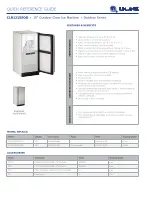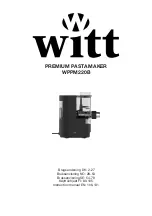
9
71504185-0-00
EN
heat and in a well-ventilated place (fig.6).
I
Connect only to the drinking water network
(Fig. 5)
5. Before performing the electrical connections, per-
form the hydraulic al ones.
6. Connect the provided 3/4" feeding pipe to the ma-
chine and to the feeding pipe with cold drinking water.
For practicality and safety reasons, it is recommended
to apply a shut-off valve, not supplied by us (fig.7: 1.
main switch; 2. socket; 3. plug; 4. hydraulic feeding;
5. valve; 6. water drainage from the condenser: water
refrigerating version; 7 water drainage from the bin; 8
water drainage with open drain pipe).
7. Apply on the machine drainage fitting the supplied
flexible tube with an inside diameter of 20 mm and of
a suitable length (not exceeding one meter from the
machine) to reach the drain trap
- If the supply water contains a lot of impurities, you
should install a filter on the water supply network up
-
stream of the device.
- If the water is very hard, i.e. full of minerals and their
derivatives, you should install a suitable water softener
on the water supply to prevent limescale from forming
in the water circuit.
- In order to avoid that the ice absorbs unpleasant
odours and flavours, never keep in the bin food, bot
-
tles and other similar things.
- During the normal operation, do not leave open the
door of the ice bin.
3.4 Connection to the electrical power supply
!
We decline any liability for damages to per-
sons, animals or things resulting from failure to
ground the equipment and the performance of an
electrical system which is not compliant with ap-
plicable regulations.
Install an omnipolar mains disconnection device in the
power supply system which provides full disconnec-
tion under category III overvoltage conditions in ac-
cordance with current regulations.
The connection to the power network must be carried
out in accordance with applicable national regulations
and by qualified and authorised personnel.
Before connecting the equipment to the power net-
work, make sure that the network voltage corresponds
to the one indicated on the identification plate (Fig. 10).
Check that the electrical system is adequate to the
maximum absorbed power of the equipment indicated
on the identification plate.
disposed of according to the regulations in force in the
country in which the device is used. In any case, noth-
ing must be dispersed in the environment.
3.3 Positioning
The appliance:
- must be installed in places where it can be
checked by qualified personnel.
- must not be installed outdoors.
- must not be installed in dusty environments (Fig.
8).
- must not be put in places with the presence of
water jets.
- must not be washed with water jets.
- must be installed and tested in full compliance
with accident prevention regulations, traditional
regulations and current regulations.
- must be positioned at a minimum distance of 150
mm from the rear wall
- Avoid places exposed to direct sun rays, closed
spaces with high temperatures and poor ventila-
tion and avoid installing the machine close to any
source of heat (Fig. 6)
The installer should check any fire prevention require
-
ments (contact the local fire brigades for proper indi
-
cations).
Level the equipment by means of the adjustment feet
(Fig. 3).
If the devices are not levelled, their operation and con-
densation discharge might be compromised.
1
Before commissioning the ice maker, perform
the following operations:
1. Check that the device has not suffered any damage
due to transportation (fig.2)
2. Extract from the bin, all supplied materials: feeding
tube, exhaust pipe, documentation and any accesso-
ries.
3. Clean the inside of the bin with a sponge soaked
in warm water mixed with a little bicarbonate of soda;
rinse with clean water and properly dry.
4. Place the ice maker in a definitive place making
sure that it is perfectly flat (fig.3)
i
Note:
when choosing the environment where to
install the machine, make sure that:
- the ambient temperature does not drop under
10°C (50°F) and does not exceed 43°C (110° F).
- the water temperature should not be under 10°C
(50°F) and should not exceed 32°C (90°F) (fi
g.4).
- the feed water pressure should not be under 0.1 MPa
(1 bar) and it should not exceed 0.5 MPa (5 bar). If the
pressure exceeds 0.5 MPa, apply a pressure reducer
to the water feeding of the machine (fig.5).
-
the water conductivity must not be less than 10 μs /
cm at 25° C ambient temperature
.
- the machine should be kept away from sources of
Содержание B130C
Страница 3: ...R290 R134a ...
Страница 4: ......
Страница 5: ......
Страница 18: ...R290 R134a ...
Страница 19: ......
Страница 20: ......
Страница 33: ...R290 R134a ...
Страница 34: ......
Страница 35: ......
Страница 48: ...R290 R134a ...
Страница 49: ......
Страница 50: ......
Страница 63: ...R290 R134a ...
Страница 64: ......
Страница 65: ......
Страница 78: ...R290 R134a ...
Страница 79: ......
Страница 80: ......
Страница 93: ...R290 R134a ...
Страница 94: ......
Страница 95: ......
















































